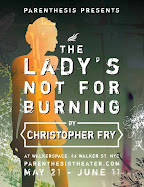Eugene O'Neill Theatre
In the lobby, I hear music coming from the theater and I think maybe I’m in the wrong place. Did I perhaps wander into a concert venue? I check the sign next to Will Call – FELA! – nope this is the right place. Did I get here late? Has it started? 1:45pm. Fifteen minutes early for the Wednesday matinee. Hmm, okay.
I walk into the theater and now I understand. It’s a party as soon as you enter. Live music is coming from a band on stage – African drums, jazz horns, and something electric rolling together in a forward-moving syncopation. Women in short, ornamented skirts stand near the wings, rolling their hips and popping their behinds to the beat. Men in leisure suits and fedoras saunter about, take a stroll down the catwalk that extends from the stage along one wall of the theater. The house itself is decked out too. Projections of newspaper headlines mix with murals and masks on every wall. Strings of lights are hung from the ceiling all the way into the balcony.
I have entered The Shrine, the program tells me. Fela Kuti’s Nigerian hot spot of the late 1970’s. The bar is open, I’m further informed, and I am welcome to drink in my seat. Okay, I see. We’re trying to create something a little different here on the B-way today. Alright, I’m feeling it.
The show begins and the actor playing Fela addresses us exuberantly as patrons of his nightclub. I enjoy his tight-voweled West-African speech. It’s as staccato and musical as Fela’s songs. And I’m enjoying him, our Fela. I’m way up in the balcony but his charisma is reaching me. I’m guessing this is how the real Fela became such a legend and political icon. He had things to say, and talent, but he must also have had charm.
The lights are still on in the house and I suppose I should have taken this as a clue. Because before I know it we have arrived at audience participation time. Everybody on their feet. Everyone get up. We’re going to learn how to move our hips. Yep, that’s right. This Wednesday matinee audience of blue hairs and tourists is about to learn how to pop a booty.
The reluctance is palpable. Especially up in the thin air of the balcony. We’re a little more exposed up here. Not as many people. The dancers and musicians aren’t so close. It’s a little harder to argue that we’ve been taken over by the rhythm or the moment. I’m torn. I really want to get down with this. If I were down in the orchestra among the masses I’m pretty sure I’d be full-on rump-shaking, even though I’m here alone. I mean, I could use a good rump-shaking. Up here in the balcony, though, I’m in the first row. Everyone behind can see me. I’m not sure I want to give them all a show. Which is strange because I rock out on the cardio machines on the gym all the time. Full on dork disco moves on the arc trainer and everything. Don’t seem to care there. For some reason I’m caring here.
Thankfully, two lovely women behind me are extremely ready to make this happen. They are on their feet and whooping, hips rocking around the faces of their clocks, I’m sure, though I don’t turn around to look. I use their enthusiasm as cover and try to get a little groove on. All I can help thinking though is how I wish I’d come here on a Saturday night. When the audience might be a little more tipsy and, well, younger. Maybe a little less white. No offense to my father’s people, but I’m pretty sure I’m looking at a couple busloads of shocked Oregonians down there. No, wait, look. There are a couple of them doing it up. Okay cool, it actually looks like people are trying to give it a little something here. Doing their best.
Which is good because the performers in the show are definitely giving it up. I’m really enjoying it. The guy playing Fela is hypnotic. So are all those ornamentally-skirted backsides up there. And I think I'm getting a sense, maybe, of what it might have been like in 1970’s in Nigeria. What the import of these songs are. I’m getting a sense. I'm feeling I can guess at how the defiance, pride, and subversion of the lyrics might have fed people. How Fela’s lyrics – coupled with this driving mix of funk and jazz and African chants, coupled with Fela himself – might have provoked a release in people. Caused in them a need to act. An explosive need. Yeah I’m getting a bit of a sense of that. I’m feeling I can guess at that right now. Yeah, I’m feeling it.




